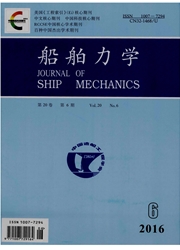

 中文摘要:
中文摘要:
以三类内孤立波理论(KdV、eKdV和MCC)的适用性条件为依据,将内孤立波诱导上下层深度平均水平速度作为入口条件,采用Navier-Stokes方程为流场控制方程,建立了两层流体中内孤立波对直立圆柱体强非线性作用的数值模拟方法。结果表明,数值模拟所得内孤立波波形及其振幅与相应理论和实验结果一致,并且直立圆柱体内孤立波水平力、垂向力及其力矩数值模拟结果与实验结果吻合。直立圆柱体内孤立波载荷由波浪压差力、粘性压差力和摩擦力构成,其中摩擦力很小,可以忽略;对于水平力,其波浪压差力与粘性压差力量级相当,流体粘性的影响显著;对于垂向力,粘性压差力很小,流体粘性影响可以忽略。此外,直立圆柱体对内孤立波的波形及其诱导流场的影响很小,因此采用Morison公式和傅汝德—克雷洛夫力分别计算其内孤立波水平力和垂向力是可行的。
 英文摘要:
英文摘要:
According to the applicability conditions for three types of internal solitary wave theories including KdV, eK dV and MCC, a numerical method based on the Navier-Stokes equations in a twolayer fluid was presented to simulate the strongly nonlinear interaction between internal solitary waves and the vertical cylinder, where the velocity-inlet boundary is applied by using of the depth-averaged velocities in the upper-and lower-layer fluids induced by the internal solitary wave. Numerical results show that the waveform and amplitude of the internal solitary waves are in good agreement with the experimental and theoretical results. The horizontal and vertical forces, as well as torques on the vertical cylinder obtained from the numerical method also agree well with experimental results. Besides, the numerical results indicate that the horizontal and vertical forces on the vertical cylinder due to internal solitary waves can be divided into three components, including the wave and viscous pressure-difference forces, as well as the frictional force, where the fractional force is not significant and can be neglected; for the horizontal force, the orders of the magnitudes between the wave and viscous pressure-difference forces are the same, which shows that the effect of the fluid viscosity is significant; for the vertical force, the component of the viscous pressure-difference force is not significant so that the effect of the fluid viscosity can also be neglected. Moreover, the effects of the vertical cylinder on the waveform and flow field induced by the internal solitary wave are small.Therefore, it is feasible to calculate the horizontal and vertical forces on the vertical cylinder due to internal solitary waves by the Morison and Froude-Krylov formulas respectively.
 同期刊论文项目
同期刊论文项目
 同项目期刊论文
同项目期刊论文
 期刊信息
期刊信息
